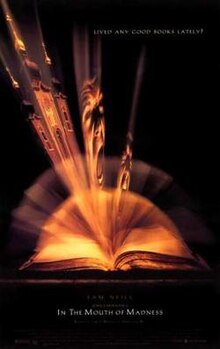In the Mouth of Madness
| In the Mouth of Madness | |
|---|---|

Theatrical release poster
|
|
| Directed by | John Carpenter |
| Produced by | Sandy King |
| Written by | Michael De Luca |
| Starring | |
| Music by | John Carpenter Jim Lang |
| Cinematography | Gary B. Kibbe |
| Edited by | Edward A. Warschilka |
| Distributed by | New Line Cinema |
|
Release date
|
|
|
Running time
|
95 minutes |
| Country | United States |
| Language | English |
| Budget | $8 million |
| Box office | $8.9 million (domestic) |
In the Mouth of Madness (also known as John Carpenter's In the Mouth of Madness) is a 1994 American psychological Lovecraftian horror film directed and scored by John Carpenter and written by Michael De Luca. It stars Sam Neill, Julie Carmen, Jürgen Prochnow, David Warner and Charlton Heston. Informally, the film is the third installment in Carpenter's Apocalypse Trilogy, preceded by The Thing and Prince of Darkness.
In the midst of an unspecified disaster, Dr. Wrenn (David Warner) visits John Trent (Sam Neill), a patient in a psychiatric hospital, and Trent recounts his story:
Trent, an insurance investigator, has lunch with a colleague who preps him on his next assignment: investigating a claim by New York-based Arcane Publishing. During their conversation, Trent is attacked by a man wielding an axe who, after asking him if he "reads Sutter Cane", is shot dead by a police officer before he can harm Trent. The man was Cane's agent, who went insane and killed his family after reading one of Cane's books.
Trent meets with Arcane Publishing director Jackson Harglow (Charlton Heston), who tasks him with investigating the disappearance of popular horror novelist Sutter Cane (Jürgen Prochnow), and recovering the manuscript for Cane's final novel. He assigns Cane's editor, Linda Styles (Julie Carmen), to accompany him. Linda explains that Cane's stories have been known to cause disorientation, memory loss and paranoia in "less stable readers". Trent is skeptical, convinced that the disappearance is a publicity stunt. Trent notices red lines on Cane's book's covers which, when aligned properly, form the outline of New Hampshire and mark a location alluded to be Hobb's End, the fictional setting for many of Cane's works.
...
Wikipedia
